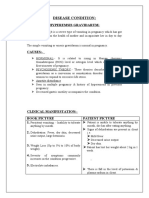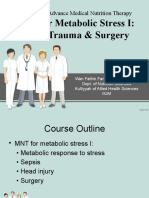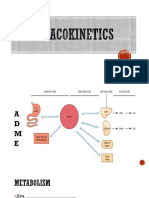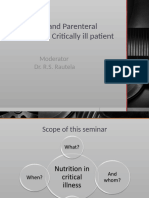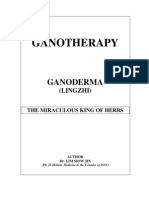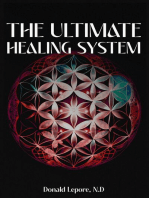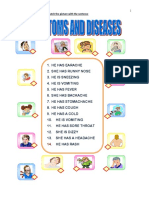0 ratings0% found this document useful (0 votes)
574 viewsMetabolic Stress Case Study
Metabolic Stress Case Study
Uploaded by
dakota1. Mr. Angelo is a 65-year-old male burn patient with 40% total body surface area burns including his face, back, buttocks, genitalia, and extremities. He is receiving fluid resuscitation, nutritional support via tube feeding, and various medications to manage his conditions.
2. His current tube feeding is providing 2,650 kcals per day with the goal of meeting his increased caloric needs from his burn injury and hypermetabolic state. Monitoring of his intake, labs, and tolerance is needed.
3. Special attention should be paid to drug-nutrient interactions from his various medications, including effects on glucose, electrolytes, iron, and hepatic
Copyright:
© All Rights Reserved
Available Formats
Download as DOCX, PDF, TXT or read online from Scribd
Metabolic Stress Case Study
Metabolic Stress Case Study
Uploaded by
dakota0 ratings0% found this document useful (0 votes)
574 views10 pages1. Mr. Angelo is a 65-year-old male burn patient with 40% total body surface area burns including his face, back, buttocks, genitalia, and extremities. He is receiving fluid resuscitation, nutritional support via tube feeding, and various medications to manage his conditions.
2. His current tube feeding is providing 2,650 kcals per day with the goal of meeting his increased caloric needs from his burn injury and hypermetabolic state. Monitoring of his intake, labs, and tolerance is needed.
3. Special attention should be paid to drug-nutrient interactions from his various medications, including effects on glucose, electrolytes, iron, and hepatic
Original Description:
Medical Nutrition Therapy II Case Study ADIME chart note + study questions
Copyright
© © All Rights Reserved
Available Formats
DOCX, PDF, TXT or read online from Scribd
Share this document
Did you find this document useful?
Is this content inappropriate?
1. Mr. Angelo is a 65-year-old male burn patient with 40% total body surface area burns including his face, back, buttocks, genitalia, and extremities. He is receiving fluid resuscitation, nutritional support via tube feeding, and various medications to manage his conditions.
2. His current tube feeding is providing 2,650 kcals per day with the goal of meeting his increased caloric needs from his burn injury and hypermetabolic state. Monitoring of his intake, labs, and tolerance is needed.
3. Special attention should be paid to drug-nutrient interactions from his various medications, including effects on glucose, electrolytes, iron, and hepatic
Copyright:
© All Rights Reserved
Available Formats
Download as DOCX, PDF, TXT or read online from Scribd
Download as docx, pdf, or txt
0 ratings0% found this document useful (0 votes)
574 views10 pagesMetabolic Stress Case Study
Metabolic Stress Case Study
Uploaded by
dakota1. Mr. Angelo is a 65-year-old male burn patient with 40% total body surface area burns including his face, back, buttocks, genitalia, and extremities. He is receiving fluid resuscitation, nutritional support via tube feeding, and various medications to manage his conditions.
2. His current tube feeding is providing 2,650 kcals per day with the goal of meeting his increased caloric needs from his burn injury and hypermetabolic state. Monitoring of his intake, labs, and tolerance is needed.
3. Special attention should be paid to drug-nutrient interactions from his various medications, including effects on glucose, electrolytes, iron, and hepatic
Copyright:
© All Rights Reserved
Available Formats
Download as DOCX, PDF, TXT or read online from Scribd
Download as docx, pdf, or txt
You are on page 1of 10
At a glance
Powered by AI
Mr. Angelo is a 65-year-old male with 40% total body surface area burns involving his face, back, buttocks, genitalia, and extremities. He requires fluid resuscitation, nutritional support, and wound care for recovery.
Burn wounds are classified into four degrees based on depth of tissue involvement. Mr. Angelo has partial thickness burns over his lower back and buttocks, 1st degree burns near his umbilicus, and partial thickness and full thickness circumferential burns to his extremities.
The 'rule of nines' is used to assess burn percentage based on body surface areas. Mr. Angelo's burns cover 40% of his total body surface area. The Parkland formula calculates fluid needs based on weight, burn percentage, and is administered over 24 hours to maintain adequate circulation.
FN 418/618: Medical Nutrition Therapy II Spring 2017
Nutrition Support for Burn Injury Case Study
Dakota Cossairt
Dropbox Feedback
Need to assess his current TF rate as this is his current nutritional intake. If you don't do this then how are y
nutritional needs are being met or not?
Need to include that he is currently receiving propofol as this provides significant kcals to him.
Also need to include how much protein the patient will receive from the goal rate of tube feeding.
A Mr. Angelo is a 65 yo male presented as level 1 trauma with 40% total
body surface area burns. ENT service performed a
nasopharyngolaryngoscopy. Patient is subject to a bronchoscopy. Physical
findings include laryngeal edema and soot on the vocal cords bilaterally.
Medical history includes diabetes, HTN, and GERD. Lab values indicate
elevated levels of CRP and decreased levels of protein, albumin, and pre-
albumin. Stable weight for past 6 months. Patient is on ventilator. MD
assessment included hyperkalemia, protein-calorie malnutrition, acute
kidney injury, oliguria, and respiratory failure. Patient was started on fluid
resuscitation per Parkland formula using Lactated Ringers @ 610 mL/hr.
Ht. = 72 Wt. = 156.6# IBW= 178# %IBW= 88% BMI =
21.3
Recommended kcals = 2600-2700 kcals/day (Ireton-Jones Equation)
Protein Requirements = 107-142 g/day (1.5-2.0 g/kg)
Fluid Requirements = 2000-2200 cc/day
Nutrition order = NPO with TF Impact with Glutamine @ 60 mL/hr
D Increased nutrient needs R/T increased energy expenditure and protein
loss AEB protein-calorie malnutrition, decreased total protein, albumin and
pre-albumin levels, and burn trauma
I RD recommends patient continue TF with Impact with Glutamine.
Advance 20 mL/hr every 4 hours until goal rate of 85 cc/hr is achieved. This
will provide patient with 2,650 kcal/day. Introduce solid food when GI tract is
ready; advance as quickly as possible from liquids to solids.
ME RD will follow-up with patient daily to assess intake of nutritional
intake, input/output, and hydration status. Monitor weight, lab values. Assess
patients tolerance to nutritional support.
Understanding the Diagnosis and Pathophysiology
1. Describe how burn wounds are classified. Identify and describe
Mr. Angelos burn injuries.
a. Burn wounds are classified into 4 different categories.
i. 1st degree
1. Tissue layer = epidermis
2. Skin thickness = 0.01
nd
ii. 2 degree
1. Tissue layer = epidermis & dermis
2. Skin thickness = 0.02
iii. 3rd degree
1. Tissue layer = epidermis, dermis & subcutaneous
tissue
2. Skin thickness = 0.035
iv. 4th degree
1. Tissue layer = epidermis, dermis, subcutaneous
tissue & muscle
2. Skin thickness = 0.04
b. Mr. Angelos burn injuries cover 40% of his total body surface
area. The burns involve his entire face. He has partial thickness
burns over his lower back and buttocks. There are partial
thickness and 1st degree burns near his umbilicus. His genitalia
has blistering over the scrotum and head of his penis. There is
partial thickness burns to his bilateral upper extremities and full
thickness circumferential burns to his lower extremities. Overall,
his skin condition is weeping, sloughing, blistering, and there is
necrosis.
2. Explain the rule of nines used in assessment of burn injury.
a. The rule of nines assesses the % of burn on the total body
surface area.
i. Head/neck - 9% TBSA
ii. Each arm - 9% TBSA
iii. Anterior thorax - 18% TBSA
iv. Posterior thorax - 18% TBSA
v. Each leg - 18% TBSA
vi. Perineum - 1% TBSA
3. Mr. Angelos fluid resuscitation order was: LR @ 610 mL/hr X
first 8 hours and decrease to 305 mL/hr X 16 hours. What is the
primary goal of fluid resuscitation? Briefly explain the Parkland
formula. What common intravenous fluid is used in burn
patients for fluid resuscitation? What are the components of
this solution?
a. Fluid Resuscitation
i. Primary goals
1. Achieve adequate tissue perfusion to prevent tissue
death
2. Maintain sufficient circulatory volume
b. Parkland Formula
i. Total fluid requirement in 24 hrs
ii. 4 mL X TBSA (%) X body weight (kg)
iii. 50% given in 1st 8 hours
iv. 50% given in next 16 hrs
v. Used to estimate needs for fluid resuscitation
vi. Calculated amount based on patients BW, age, and %TBSA
of the burn
c. Common intravenous fluids
i. Isotonic crystalloids
1. Most commonly used
2. Cheaper
3. Solution of sterile water w/ added electrolytes
4. Normal saline and Lactated Ringers (LR)
ii. Hypertonic solutions
1. Contain more sodium
2. Resuscitate patients using lower total fluid volume
iii. Colloids
1. Prove protein in solution
2. Protein leakage
5. Burns are often described as one of the most metabolically
stressful injuries. Discuss the effects of a burn on metabolism
and how this will affect nutritional requirements.
a. Hyper-metabolism
b. Energy needs usually increase 20-30%
c. Increased fluid needs
d. Specific vitamin and mineral supplementation is encouraged
e. Caloric goals can become 2xREE, but should not exceed that
f. Protein
i. Increased protein use in would healing and
gluconeogenesis
ii. Protein catabolism
iii. Protein should be 20-25% of total kcals
g. Increased urinary excretion
i. Increased nitrogen losses in urine
h. Weight loss is common
i. Lack of caloric intake
ii. Should not lose >10% UBW during healing process
i. Wound healing can only occur in anabolic state
6. List all medications that Mr. Angelo is receiving. Identify the
action of each medication and any drug-nutrient interactions
that you should monitor.
Medication Dosage Action Drug-Nutrient
Interactions
500 mg
iron absorption Iron
Ascorbic Acid every 12 Vitamin Antiscorbutic
toxicity
hrs
0.12% oral
solution 15 Disinfectant & topical anti- n/a
Chlorhexidine
mL every infective agent
12 hrs
20 mg Histamine H2-receptor
Famotidine Tablet every 12 antagonist inhibition of Hepatic function
hrs gastric secretion
5,000 units
Heparin Injections every 8 Anticoagulant Blood & potassium
hrs
Regular
injection Peptide hormone Glucose, CHO intake,
Insulin
every 6 improves glycemic control urine ketones
hrs
Multivitamin Tablet 1 Tab daily Vitamin n/a
Zinc Sulfate 220 mg Treat or prevent low levels Give hour before or 2 hrs
daily of zinc mineral after tube feeding
supplement
5 mg
Methadone every 8 Opioid Analgesic Narcotic Avoid grapefruit
hrs
Anabolic effect, need to
10 mg Synthetic hormone
meet required energy
Oxandrolone every 12 anabolic steroid promote
intake & protein. Assess
hrs weight gain
glucose
Laxative simulant treat
8.6 mg Electrolyte balance, fiber
Senna Tablet constipation & empty large
daily and fluid intake
intestine before surgery
100 mg
Electrolyte balance, fiber
Docusate Oral Liquid every 12 Laxative stool softener
and fluid intake
hrs
1% cream
topical Topical antimicrobial
Silver Sulfadiazine n/a
application activity
daily
650 mg
oral every Analgesic & antipyretic
Acetaminophen Allergic rxns
4 hrs as effects
needed
100 mg in
sodium
chloride Hypotonic-sedative drug
Midazolam HCI Avoid grapefruit, herbal
0.9% 100 anxiolytic & amnestic
(Versed) sedatives & stimulants
mL IV properties sedation
infusion (1
mg/hr)
0.5-1 mg
Hydromorphone IV every 3 Opioid analgesic relief of
Asses hydration status
(Dilaudid) Injection hrs as pain narcotic
needed
50-100
mcg IV Narcotic analgesic mu-
Fentanyl (Sublimaze) Fluid status & electrolyte
every 15 opioid agonist adjunct to
Injection balance for dehydration
min as anesthetics
needed
10 mg/mL
premix
infusion Anaesthetic agent
Propofol (Diprivan) (25 induction and/or Triglycerides & lipid panel
mcg/kg/mi maintenance of anesthesia
n IV
continuous
Thiamin 100 mg X Vitamin Vitamin B Increase CHO intake
antioxidant
erythropoietic cognition
and mood modulatory
3 days antiatherosclerotic
putative ergogenic
detoxification
antiberiberi
1 mg X 3 Vitamin Vitamin B Inhibited by vitamin C,
Folate
days antianemic B12 and iron
Understanding the Nutrition Therapy
7. Using evidence-based guidelines, describe the potential
benefits of early enteral nutrition in burn patients.
a. Benefits of early enteral nutrition include reduced disease
severity, decreased length of time in the ICU and decreased
infectious morbidity and decreased mortality.
8. What are the common criteria used to assess readiness for the
initiation of enteral nutrition in burn patients?
a. The first step in assessing a patients readiness for initiation of
enteral nutrition is to establish their hemodynamic stability. To
establish this, the patients heart rate, blood pressure, cardiac
output, oxygen, and mean arterial pressure saturation should be
assessed.
b. A patient should not receive EN until they are fully resuscitated
and/or stable
9. What are the specialized nutrient recommendations for the
enteral nutrition formula administered to burn and trauma
patients per ASPEN/SCCM guidelines?
a. Glutamine should be added to standard enteral formula in
burned patients
b. 10.4 Burns: Trace elements (Cu, Se and Zn) should be
supplemented in a higher than standard dose.
c. ASPEN Guideline F1. Based on expert consensus, we suggest
that a fermentable soluble fiber additive be considered for
routine use in all hemodynamically stable medical and surgical
ICU patients placed on a standard enteral formulation. We
suggest that 1020 grams of a fermentable soluble fiber
supplement be given in divided doses over 24 hours as
adjunctive therapy if there is evidence of diarrhea.
d. ASPEN Guideline F3. We suggest that a combination of
antioxidant vitamins and trace minerals in doses reported to be
safe in critically ill patients be provided to those patients who
require specialized nutrition therapy
e. ASPEN Guideline F4: The addition of enteral glutamine to an
EN regimen (not already containing supplemental glutamine)
should be considered in burn, trauma, and mixed ICU patients
f. No general amount can be recommended as EN therapy has to
be adjusted according to the progression/course of the disease
and to gut tolerance. During the acute and initial phase of critical
illness an exogenous energy supply in excess of 2025 kcal/kg
BW/day may be associated with a less favorable outcome (C).
During recovery (anabolic flow phase), the aim should be to
provide 2530 total kcal/kg BW/day (C).
Source: http://espen.info/documents/enicu.pdf &
http://journals.sagepub.com/doi/pdf/10.1177/0148607115621863 &
http://www.criticalcarenutrition.com/docs/BOB/BeaumontGuidelines.
10. What additional micronutrients will need
supplementation in burn therapy? What dosages are
recommended?
a. Glutamine
i. 0.3-0.5 g/kg/day for 10-g doses via feeding tube 2-4 X daily
b. Zinc
i. 20% TBA full thickness OR 30% TBSA
ii. 30 mg elemental/day intravenously X 5 days
AND THEN
iii. 50 mg elemental zinc daily by mouth or feeding tube
c. Selenium
i. 20% TBA full thickness and intubated OR 30% TBSA
ii. 1000 g/day parenterally X 14 days
AND THEN
iii. 200 g twice daily by mouth or feeding tube
d. Vitamin C
i. 20% TBA full thickness OR 30% TBSA
ii. 500 mg/day 2x/day by mouth or feeding tube
e. Vitamin E
i. 400 units 2x/day by mouth or feeding tube
Nutrition Assessment
11. Using Mr. Angelos height and admit weight, calculate
IBW, %IBW, BMI, and BSA.
IBW = 178#
106# + (6# * 12) = 178#
%IBW = 88%
(156.6# / 178#) * 100 = 88%
BMI = 21.3 kg/m2
71.2kg/3.345m2 = 21.3
BSA = 1.902 m2
(182.88cm * 71.2kg) / 3600 = 3.61696 3.61696 = 1.902 m2
12. Energy requirements can be estimated using a variety of
equations. The Xie and Zawacki equations are frequently used.
Estimate Mr. Angelos energy needs using these equations.
How many kcal/kg does he require based on these equations?
Ht. = 72 182.88 cm 1.823 m 3.3489 m2
Wt. = 156.6# 71.2 kg
EEE = 1784 11(65) + 5(71.2) + 244(1) + 239(1) + 804(1) = 2712 kcal
2700 kcals/day
13. Determine Mr. Angelos protein requirements. Provide the
rationale for you estimate.
Protein Requirements = 107-142 g/day (1.5-2.0 g/kg)
1.5g * 71.2kg = 106.8 g protein
2.0g * 71.2kg = 142.4 g protein
Recommend 1.5-2.0 because the patient is a burn victim and they have
increased protein needs for wound healing.
14. The MDs progress note indicates that the patient is
experiencing acute kidney injury. What is this? If the patients
renal function continues to deteriorate and he needs
continuous renal replacement therapy, what changes will you
make to your current nutritional regimen and why?
a. Acute Kidney Injury
i. A sudden episode of kidney failure or kidney damage,
which happens within a few hours or a few days.
ii. It causes build-up of waste products in the blood
iii. Makes it hard for the kidneys to keep the right balance of
fluids in the body
iv. Also affects other organs like the brain, heart, and lungs
Source: https://www.kidney.org/atoz/content/AcuteKidneyInjury
Nutrition Diagnosis
16. Identify at least 2 of the most pertinent nutrition
problems and the corresponding nutrition diagnoses.
a. Increased protein needs for wound healing
b. Increased fluid needs
c. Malnutrition
17. Write a PES statement for each nutrition problem.
a. Increased nutrient needs R/T increased energy expenditure and
protein loss AEB protein-calorie malnutrition, decreased total
protein, albumin and pre-albumin levels, and burn trauma
b. Inadequate fluid intake R/T increased fluid needs AEB oliguria,
poor skin turgor, and yellow urine color
Nutrition Intervention
18. The patient is receiving enteral feeding using Impact with
Glutamine @ 60 mL/hr. determine the energy and protein
provided by this prescription. Provide guidelines to meet the
patients calculated needs using the Xie equation.
a. Impact w/ Glutamine
i. Caloric Density = 1.3 kcal/mL
ii. Osmolarity
1. 630 mOsm/kg water
iii. Carbs 46% total kcal
iv. Protein = 24% total kcal
v. Lipid = 30% total kcal
Calories
60 mL/hr * 24 hr/day = 1440 mL/day or 1.44 L/day
1.3 kcal/mL * 60 mL/hr = 78 kcal/hr
1.3 kcal/mL * 1440 mL/day = 1872 kcal/day
Protein
78 g/L * 1.44 L = 112.32 g protein
112.32 g * 9g/kcal = 1,011 kcal from protein
19. By using the information on the intake/output record,
determine the energy and protein provided during this time
period. Compare the energy and protein provide by the enteral
feeding to your estimation of Mr. Angelos needs.
a. Input from enteral feeding = 565 mL/day
b. (565mL / 1440mL) * 100 = 39.2%
c. 1872 kcal * 39.2% = 734 total kcal currently
d. 1,011 kcal from protein * 39.2% = 396 kcal from protein
currently
e. Patient is only receiving 39.2% of his calculated energy needs.
He is currently only receiving 734 kcal/day and 396 kcal from
protein.
20. One of the residents on the medical team asks you if he
should stop the enteral feeding because the patients blood
pressure has been unstable. What recommendation can you
make to the patients critical care team regarding tube feeding
and hemodynamic status?
a. Fluctuating blood pressure (hypotension) is common in critically
ill patients and can be due to GI intolerance.
Nutrition Monitoring and Evaluation
21. List factors that you would monitor to asses the tolerance
to and adequacy of nutrition support.
a. Daily I/O of fluid
b. Weight
c. Nutritional intake
d. Lab values
e. Hydration status
f. Stool output/consistency
g. Distension and comfort in the abdomen
22. What is the best method to assess caloric needs in
critically ill patients? What are the factors that need to be
considered before the test is ordered?
a. Ireton-Jones for burn victims
b. 25-30 kcal/kg for non-obese patients
c. 14-18 kcal/kg of ABW
d. 22 kcal/kg of IBW
You might also like
- Homer Xiang Adime NoteDocument3 pagesHomer Xiang Adime Noteapi-582282306100% (1)
- Quinton Protocols For MedicinsDocument9 pagesQuinton Protocols For MedicinsAlexandru Cristian StanciuNo ratings yet
- Tratado de PsiquiatriaDocument31 pagesTratado de Psiquiatriafisiojim29% (7)
- Case Study Question 29Document12 pagesCase Study Question 29api-532124328100% (2)
- NCP GDMDocument10 pagesNCP GDMmishti95% (21)
- Neurological Disease CSDocument9 pagesNeurological Disease CSdakotaNo ratings yet
- Pediatric Weight Management CSDocument7 pagesPediatric Weight Management CSdakota100% (1)
- Casestudy 2 BurnsDocument16 pagesCasestudy 2 BurnsNOOR QASIMNo ratings yet
- Burn Case StudyDocument9 pagesBurn Case Studydakota100% (2)
- FHP - NCP - Kidney FailureDocument9 pagesFHP - NCP - Kidney FailureFrancis AdrianNo ratings yet
- Activity # 7 Fluid and Electrolyte Balance (WITH NCP)Document15 pagesActivity # 7 Fluid and Electrolyte Balance (WITH NCP)Louise OpinaNo ratings yet
- Nursing Care Plan: Saint Louis University School of Nursing Bonifacio Street, Baguio CityDocument3 pagesNursing Care Plan: Saint Louis University School of Nursing Bonifacio Street, Baguio CitySoniaMarieBalanayNo ratings yet
- Disease Condition:: Hyperemsis Gravidarum: DefinitionDocument4 pagesDisease Condition:: Hyperemsis Gravidarum: DefinitionPriyanka John100% (1)
- Nutritionincriticallyillnew 141027102200 Conversion Gate02Document37 pagesNutritionincriticallyillnew 141027102200 Conversion Gate02Isha ChhedaNo ratings yet
- المستند (7) Document3 pagesالمستند (7) Mawadh AlsbhiNo ratings yet
- Combustion: Fajar Ari NugrohoDocument34 pagesCombustion: Fajar Ari NugrohoIndah KusriantiNo ratings yet
- HYPOKALEMIADocument3 pagesHYPOKALEMIADienizs Labini TadenaNo ratings yet
- Care Plan Number 2Document5 pagesCare Plan Number 2Teddy mc Bones100% (1)
- Ikobho Surgical NutritionDocument59 pagesIkobho Surgical NutritionPrincewill SeiyefaNo ratings yet
- 1 Metabolic Response To Injury PDFDocument50 pages1 Metabolic Response To Injury PDFyayayanizaNo ratings yet
- Nursing Exam Questions 2023 Part 3Document6 pagesNursing Exam Questions 2023 Part 3Lejo SunnyNo ratings yet
- Metabolic Stress 1 Sepsis, Trauma, Surgery 2020Document71 pagesMetabolic Stress 1 Sepsis, Trauma, Surgery 2020ﱞﱞﱞﱞﱞﱞﱞﱞﱞﱞﱞﱞﱞﱞﱞﱞﱞﱞﱞﱞﱞﱞﱞﱞNo ratings yet
- Nutrition and Oral HealthDocument109 pagesNutrition and Oral Healthmangesh andhareNo ratings yet
- Pharmacokinetics PDFDocument78 pagesPharmacokinetics PDFKate EvangelistaNo ratings yet
- Concept Map PedsDocument6 pagesConcept Map Pedsapi-498759347No ratings yet
- Parenteral NutritionDocument4 pagesParenteral Nutritionmostafaswan6No ratings yet
- Epidemiological Exercises Revised 09.03.22Document12 pagesEpidemiological Exercises Revised 09.03.22Saileekitha AjamoniNo ratings yet
- فارما ابو طاهرة - 1Document54 pagesفارما ابو طاهرة - 1Mahmoud EzzatNo ratings yet
- Terapi Nutrisi: I Putu Pramana SuarjayaDocument66 pagesTerapi Nutrisi: I Putu Pramana SuarjayaMouris DwiputraNo ratings yet
- GE Problems 1st & 3rd Sept-2022Document7 pagesGE Problems 1st & 3rd Sept-2022Doctor iVJNo ratings yet
- Total Parenteral NutritionDocument12 pagesTotal Parenteral NutritionSheikhNo ratings yet
- Enteral and Parenteral nutrition in critically ill patientDocument87 pagesEnteral and Parenteral nutrition in critically ill patientRaj KumarNo ratings yet
- NCP RiskDocument2 pagesNCP RiskPaolo Vittorio Perdigueros GonzalesNo ratings yet
- Nutr 335 Adime NoteDocument2 pagesNutr 335 Adime Noteapi-533845626No ratings yet
- Kington Life Plasma IsotonicDocument69 pagesKington Life Plasma Isotonicahmad.albab.alfatihNo ratings yet
- Pharmacology Seminar 1, Drugs For Constipation and Diarrhea 2024Document30 pagesPharmacology Seminar 1, Drugs For Constipation and Diarrhea 2024mido.ali.01148515771No ratings yet
- Handout Therapy Increased Intestinal Permeability ClinicianDocument2 pagesHandout Therapy Increased Intestinal Permeability ClinicianThe Machi WellnessNo ratings yet
- Comprehensive Drug Study Ketoanalogue PDF FreeDocument2 pagesComprehensive Drug Study Ketoanalogue PDF FreeYuuki Chitose (tai-kun)No ratings yet
- Optimizing Nutrition Therapy: Dr. Paul A Dwiyanu Pulmonologist, ConsultantDocument69 pagesOptimizing Nutrition Therapy: Dr. Paul A Dwiyanu Pulmonologist, Consultantgadis ainanurlailaNo ratings yet
- Lymphoma Case StudyDocument16 pagesLymphoma Case Studyapi-622273373No ratings yet
- CLIN PHARM - Fluids and ElectrolytesDocument11 pagesCLIN PHARM - Fluids and ElectrolytesAlodia RazonNo ratings yet
- Enteral and Parental Nutrititon Case StudyDocument7 pagesEnteral and Parental Nutrititon Case Studyjikute.911No ratings yet
- Clinicobiochemical Changes in Ivermectin Toxicity in Doberman Pinscher PupsDocument4 pagesClinicobiochemical Changes in Ivermectin Toxicity in Doberman Pinscher PupsaftermathaftermathNo ratings yet
- MTLE - ASCPI Final CoachingDocument57 pagesMTLE - ASCPI Final CoachingbambasanlyNo ratings yet
- AINAEDIToptimzing NutritionalDocument69 pagesAINAEDIToptimzing Nutritionalgadis ainanurlailaNo ratings yet
- Metabolic Stress Case StudyDocument3 pagesMetabolic Stress Case Studyapi-377438367No ratings yet
- Endo Adult DavisDocument15 pagesEndo Adult Davisjohneric010408No ratings yet
- ROSABIA, Micaela Pauline J. .-BSN-2A-ISDH-GS-NURSERY-NCPDocument6 pagesROSABIA, Micaela Pauline J. .-BSN-2A-ISDH-GS-NURSERY-NCPkimberly quitonNo ratings yet
- Week 9. Burn InjuriesDocument2 pagesWeek 9. Burn InjuriesJem LoterteNo ratings yet
- Nutri PretestDocument4 pagesNutri PretestBNo ratings yet
- Resource Unit On Drugs and IVF's: College of NursingDocument7 pagesResource Unit On Drugs and IVF's: College of NursingJ Michael EscaraNo ratings yet
- Pharma For StudentsDocument23 pagesPharma For StudentsWreddit RegalNo ratings yet
- 5 6 (TPN)Document41 pages5 6 (TPN)SAISH BNo ratings yet
- حسابات الجرعة basharDocument7 pagesحسابات الجرعة basharابو الخطابNo ratings yet
- Ganotherapy02Document16 pagesGanotherapy02Nagendra PrasadNo ratings yet
- Nut 116bl Cs-Burn Britt RobinsonDocument6 pagesNut 116bl Cs-Burn Britt Robinsonapi-351321064No ratings yet
- Kerri Mini Case StudyDocument4 pagesKerri Mini Case Studyapi-522416816No ratings yet
- Gastroenteritis NCPDocument1 pageGastroenteritis NCPVenus Bactol67% (3)
- TPN ClassDocument32 pagesTPN Classgamal attamNo ratings yet
- Nutrisi Perioperatif Dan Malignancy: J.Iswanto Surabaya Surgical Update 2017 Shangri-La Hotel 11 Maret 2017 SurabayaDocument33 pagesNutrisi Perioperatif Dan Malignancy: J.Iswanto Surabaya Surgical Update 2017 Shangri-La Hotel 11 Maret 2017 Surabayaagung permanaNo ratings yet
- Clinical Medicine: Nutrition & Obesity: August 18 - Dr. Adarsh Gupta - 3-4pm - PMDocument9 pagesClinical Medicine: Nutrition & Obesity: August 18 - Dr. Adarsh Gupta - 3-4pm - PMleesaNo ratings yet
- Nutrition Support Case StudyDocument6 pagesNutrition Support Case StudydakotaNo ratings yet
- Bariatric Surgery CSDocument8 pagesBariatric Surgery CSdakotaNo ratings yet
- Malnutrition Case Study-2Document5 pagesMalnutrition Case Study-2dakota100% (1)
- Pulmonary CSDocument8 pagesPulmonary CSdakotaNo ratings yet
- Case Study TemplateDocument2 pagesCase Study TemplatedakotaNo ratings yet
- Topic 5. Environmental Pollution (8 Marks) : Q. No Option I Option II Option III Option IV Answer KeyDocument2 pagesTopic 5. Environmental Pollution (8 Marks) : Q. No Option I Option II Option III Option IV Answer KeyAbhinav GadekarNo ratings yet
- Sjögren's Syndrome. A Case Study - MFHDocument3 pagesSjögren's Syndrome. A Case Study - MFHManuel Flores HernandezNo ratings yet
- English For Midwifery Edition 1Document31 pagesEnglish For Midwifery Edition 1ricky tanujaya100% (1)
- The Impact of Shift Work On The Psychological andDocument9 pagesThe Impact of Shift Work On The Psychological andratna220693No ratings yet
- Maternal Child Nursing PDFDocument31 pagesMaternal Child Nursing PDFJonalene SoltesNo ratings yet
- TPJ3M1-02 U2: ReviewDocument11 pagesTPJ3M1-02 U2: ReviewLynn TrinhNo ratings yet
- Vet Communication HandbookDocument124 pagesVet Communication HandbookCh LiuNo ratings yet
- KRR 2 1 ElectroDocument2 pagesKRR 2 1 Electroosiris33ra8248100% (1)
- Qbase Medicine 1 MCQs For The MRCPDocument132 pagesQbase Medicine 1 MCQs For The MRCPsosoposo2100% (2)
- PediatricsDocument87 pagesPediatricsCarlos HernándezNo ratings yet
- Compilation of Reviewer For Fundamentals of Nursing PDF FreeDocument49 pagesCompilation of Reviewer For Fundamentals of Nursing PDF FreeTyler VintNo ratings yet
- Psychotherapeutic Interventions For Adults With Brain Injury - Karen G Langer Linda Laatsch Lisa Lewis - 1st Edition, March 1999 - Intl - 9781887841238 - Anna's ArchiveDocument288 pagesPsychotherapeutic Interventions For Adults With Brain Injury - Karen G Langer Linda Laatsch Lisa Lewis - 1st Edition, March 1999 - Intl - 9781887841238 - Anna's ArchiveneuromarilynNo ratings yet
- Microbiology For Allied Health StudentsDocument901 pagesMicrobiology For Allied Health StudentsBIO FloraNo ratings yet
- Antibacterial, Antifungal and Antitubercular Activity of Methanolic Extracts of Adansonia Digitata LDocument9 pagesAntibacterial, Antifungal and Antitubercular Activity of Methanolic Extracts of Adansonia Digitata LIOSRjournalNo ratings yet
- Paper Seminario Jose EpulefDocument11 pagesPaper Seminario Jose EpulefJL EulefiNo ratings yet
- Bol I EutanazijaDocument6 pagesBol I EutanazijaanarbvukNo ratings yet
- Ingles VestibularDocument7 pagesIngles VestibularLUCAS COCA MATIASNo ratings yet
- Bugis Street CsiDocument8 pagesBugis Street CsiMichelle LeeNo ratings yet
- BASIC CONCEPTS IN MEDICINAL CHEMISTRY, 3RD EDITION. (MARC W.. ZAVOD HARROLD (ROBIN M.) ) (Z-Library)Document1 pageBASIC CONCEPTS IN MEDICINAL CHEMISTRY, 3RD EDITION. (MARC W.. ZAVOD HARROLD (ROBIN M.) ) (Z-Library)duy luuNo ratings yet
- The Four HorsemenDocument9 pagesThe Four HorsemenAlexPemaNo ratings yet
- IMCI Revised For CHN 1 NEW 1st Sem 2022Document82 pagesIMCI Revised For CHN 1 NEW 1st Sem 2022Aech Euie100% (1)
- Echo Cs 310 ManualDocument36 pagesEcho Cs 310 ManualfatmirNo ratings yet
- Tracheal Mites Acarine DiseaseDocument7 pagesTracheal Mites Acarine DiseaseMonuNo ratings yet
- PSC VetDocument2 pagesPSC Vetrjanpdsn125No ratings yet
- Heat Stress at WorkplaceDocument4 pagesHeat Stress at Workplacemirali74No ratings yet
- Fungal Skin PharmacologyDocument12 pagesFungal Skin PharmacologyBrian Lemba 'x-ray'No ratings yet
- A Review Article: Myths, Beliefs and Malpractices Relating To Breastfeeding and Complementary Feeding PracticesDocument3 pagesA Review Article: Myths, Beliefs and Malpractices Relating To Breastfeeding and Complementary Feeding PracticesinventionjournalsNo ratings yet
- The Masque of The Red Death - Symbolism - Jeff TothDocument3 pagesThe Masque of The Red Death - Symbolism - Jeff Tothapi-283665533No ratings yet
- Wound Healing and Its DisordersDocument39 pagesWound Healing and Its Disordersmahdi aljamalNo ratings yet












